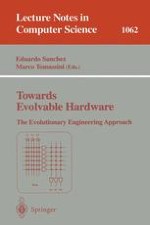1996 | ReviewPaper | Chapter
Unconstrained evolution and hard consequences
Authors : Adrian Thompson, Inman Harvey, Philip Husbands
Published in: Towards Evolvable Hardware
Publisher: Springer Berlin Heidelberg
Included in: Professional Book Archive
Activate our intelligent search to find suitable subject content or patents.
Select sections of text to find matching patents with Artificial Intelligence. powered by
Select sections of text to find additional relevant content using AI-assisted search. powered by
Artificial evolution as a design methodology for hardware frees many of the simplifying constraints normally imposed to make design by humans tractable. However, this freedom comes at some cost, and a whole fresh set of issues must be considered. Standard genetic algorithms are not generally appropriate for hardware evolution when the number of components need not be predetermined. The use of simulations is problematic, and robustness in the presence of noise or hardware faults is important. We present theoretical arguments, and illustrate with a physical piece of hardware evolved in the real-world (‘intrinsically evolved’ hardware). A simple asynchronous digital circuit controls a real robot, using a minimal sensorimotor control system of 32 bits of RAM and a few flip-flops to co-ordinate sonar pulses and motor pulses with no further processing. This circuit is tolerant to single-stuck-at faults in the RAM. The methodology is applicable to many types of hardware, including Field-Programmable Gate Arrays (FPGA's).
